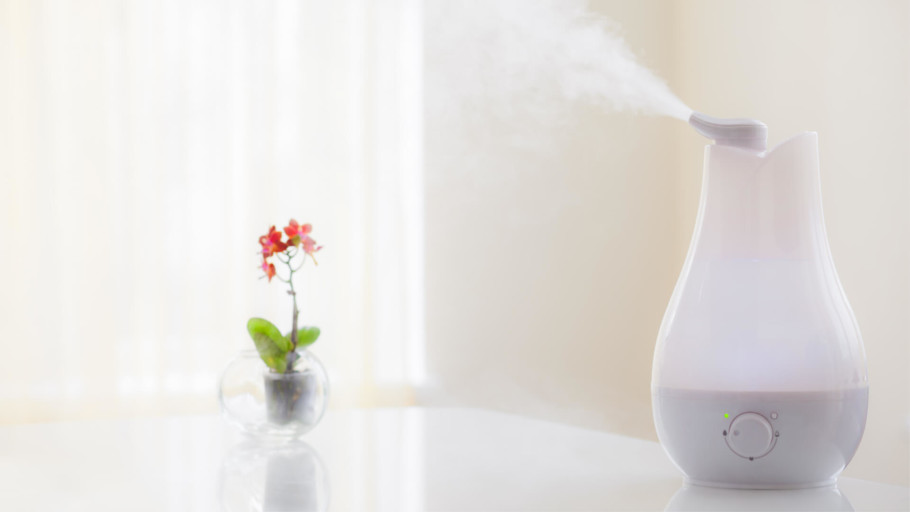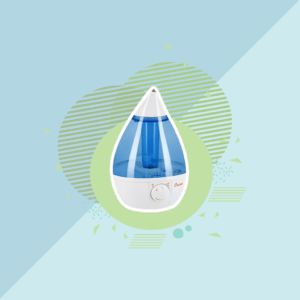Warm Mist vs Cool Mist Humidifiers: Which is Better?
If you battle with allergies, dry skin, or are simply suffering from a cold; using a humidifier is a great way to help relieve your symptoms. These clever devices fight the woes that dry air can cause by increasing moisture levels and improving your overall health.
When it comes to choosing a humidifier, however, many people struggle to decide whether a cool mist or a warm mist humidifier is best for their needs. Both types work to elevate humidity in your home, but which one is the right choice for your circumstances? In this article, we’ll break down the differences between warm mist and cool mist humidifiers and examine their benefits and drawbacks so that you can make a more informed choice for you and your family.
Humidifier Benefits
You may have noticed that breathing dry air for long periods can leave you feeling stuffy and uncomfortable. Unfortunately, these unpleasant effects are even more pronounced if you’re suffering from the flu or battling with troublesome allergies.
This is because dry air increases inflammation within your sinuses and nasal passages. Such an upsurge in inflammation can lead to itchiness, sneezing, coughing, and sometimes a painful burning sensation with each breath. In severe cases, exposure to very dry air can cause sore cracked lips, flaky skin, and even nose bleeds.
Humidifiers work to elevate levels of moisture in the air, immediately soothing the effects of dryness on your skin, breathing passages, and overall sinus structure.This means that these symptoms of dry air can be eradicated with the addition of a humidifier. What’s more, having a humidifier may prevent you and your family from getting sick in the first place. Studies have shown that maintaining an ideal level of humidity reduces the spread of the influenza virus as well as limiting the volume of dust and irritating allergens present in the air.
Warm Mist vs. Cool Mist Humidifiers
Both warm and cool mist humidifiers will elevate humidity in your home. But even though they produce similar results, they achieve this in varying ways. Read on to find out how warm and cool mist humidifiers work, and the differences in their mechanics.
Warm Mist Humidifiers
Just as their name suggests, warm mist humidifiers emit warm steam vapor into the surrounding air. You can clearly see the mist being released, much like when boiling water on the stove.
This type of humidifier is great for calming irritated sinuses and clearing nasal congestion, but they often work best in smaller rooms. Water is boiled from within the humidifier using an internal heating element. No fans are required, as the pressure created by the steam is enough to force it out into the surrounding air.
Some models will have special filters to trap any minerals present in the water, stop them from being emitted with the steam, and then allow them to condense back into a solid form as dust later.
As warm mist humidifiers contain boiling water and release hot mist, they should be placed out of reach of children and pets.
Cool Mist Humidifiers
This type of humidifier releases a cool mist into the air to increase humidity levels and make for a popular choice in hot, dry climates. When shopping for cool mist humidifiers, you’ll often find there are two different types to choose from: evaporative humidifiers and ultrasonic humidifiers. Both types emit cool mist, but they do so using different methods.
Evaporative Humidifiers
Evaporative humidifiers are rather simple in design. They are made up of a water reservoir, a wick, and a fan. Cool water is placed into the reservoir and is then naturally drawn up the wick. Once the humidifier is switched on, the fan blows air across the wick – absorbing moisture as it passes. This moisturized air is then blown out into the room, increasing humidity without adding extra heat.
Ultrasonic Humidifiers
Ultrasonic humidifiers are a little more complicated. These humidifiers break apart water molecules using a vibrating metal or ceramic plate. The plate vibrates at a very high ultrasonic frequency, shaking the molecules until they produce an invisible, cool mist that is released into the surrounding air.
As there’s no fan inside, some people prefer this type of cool mist humidifier because it is quieter than evaporative models. Ultrasonic humidifiers also create fine, white dust, though, which settles on nearby furniture. This is the result of mineral deposits found within water. Using distilled water will reduce the amount of dust that’s produced; but unfortunately, you’ll never be able to completely eliminate it.
You can find our list of the best cool mist humidifiers here.
Warm Mist and Cool Mist Humidifier Pros and Cons
Warm and cool mist humidifiers may work slightly differently, but which one is truly best for you and your family? In this section, we examine the benefits and drawbacks of each type of humidifier.
Benefits of Warm Mist Humidifiers
Warm mist humidifiers offer an effective and comforting solution to the problem of dry air. The soothing warm mist quickly relieves sore noses, congestion, chapped lips, and sinus pressure; it can also reduce the number of troublesome allergens and viruses in the air.
Unlike some types of cool mist humidifiers, warm mist humidifiers run very quietly, making them perfect for use in the bedroom. This is because they don’t use fans to distribute steam. Instead, the pressure created within the unit is enough to continually release the mist out into the surrounding air. Therefore, the only sound you’re likely to hear is a faint bubbling, which shouldn’t disturb your sleep.
This type of humidifier can also help warm up a room while maintaining ideal humidity levels. In winter time, the heating in your home will dry out the air as it warms up the space. Using a warm mist humidifier won’t replace your heating, but if you’re using it in a small room, it can make the temperature a little more comfortable without stripping the air of moisture. Furthermore, warm mist humidifiers don’t create hard-water mineral dust that settles on your surrounding furniture. This is because the water is boiled to create steam, which leaves any mineral residue behind in the reservoir.
Drawbacks of Warm Mist Humidifiers
The main issue with warm mist humidifiers is safety. Not only are they filled with boiling water, but the outer surfaces and steam emissions are often hot enough to burn bare skin if touched. As a result, this type of humidifier isn’t suitable for use around small children or rambunctious pets. If you have children and still want to use a warm mist humidifier, you should put it somewhere inaccessible to little hands and where it won’t get knocked over accidentally.
Another drawback to warm mist humidifiers is power consumption. As they’re constantly boiling water, these units eat up more electricity than cool mist humidifiers which use fans or vibration to create vapor. This additional electricity usage isn’t huge, but it’s worth considering if you’re on a tight budget.
Benefits of Cool Mist Humidifiers
Cool mist humidifiers are just as effective at relieving symptoms of exposure to dry air as warm mist models. They also help to lubricate and widen the nasal passages, release pressure on the sinuses, soothe cracked lips and fight against allergens. Since they release a cool vapor, cool mist humidifiers might make a more comfortable choice for hot and arid climates such as those in the desert states.
As mentioned earlier, cool mist humidifiers are quieter and cheaper to run than warm mist humidifiers. They’re also more affordable at the point of purchase; therefore, they’re a better choice if you need to keep an eye on your expenses. Furthermore, cool mist humidifiers are a much safer option if you have small children or pets in your home. They might make a mess if they get knocked over, but they don’t present a danger for burns like warm mist humidifiers.
Drawbacks of Cool Mist Humidifiers
The most significant drawback with cool mist humidifiers is the amount of cleaning they require. Cool mist humidifiers will harbor bacteria and mold spores if they’re not cleaned out once a week. Although they’re quite easy to clean; thoroughly cleaning your cool mist humidifier on a weekly basis may become tiresome if you have a busy lifestyle. Warm mist humidifiers don’t require cleaning as frequently as they boil the water within, thus killing any microbes that may be present.
Mineral dust is another problem with cool mist humidifiers. This is the result of hard water minerals being broken down and emitted alongside the vapor. Once these minerals are out in the air, they’ll begin to settle as fine, white dust onto your surrounding furniture. It’s possible to limit this by using distilled water or demineralization cartridges, which must be replaced annually.
| Warm Mist Humidifiers | Evaporative Cool Mist Humidifiers | Ultrasonic Cool Mist Humidifiers | |
|---|---|---|---|
| Helps Relieve Dry Skin | ✓ | ✓ | ✓ |
| Soothes Cold Symptoms | ✓ | ✓ | ✓ |
| Good for Allergies | ✓ | ✓ | ✓ |
| Quiet Operation | ✓ | X | ✓ |
| Safe for Children/Pets | X | ✓ | ✓ |
| Disperses Inhalants | ✓ | X | X |
| Economical | X | ✓ | ✓ |
| Requires Weekly Cleaning | X | ✓ | ✓ |
Which Type of Humidifier Is Better For a Cold?
Humidifiers are a perfect way to relieve congestion, coughing, and sinus pain caused by a cold. Both types will boost moisture levels in the air, so it doesn’t really matter whether you use a warm or cool mist humidifier for this purpose. That said, there are occasions when one type may be more beneficial than the other.
Warm mist humidifiers can be especially useful for heavy congestion as they’re often capable of dispersing inhalants too, thus helping to relax the airways faster. They’re also quieter than cool mist units, which will be appreciated if you’re trying to get some rest.
However, cool mist humidifiers are the safest option if your little one is suffering from a cold. Warm mist models pose a serious risk of burns if they get knocked over, touched, or if a child gets too close to the steam. The cool mist will have warmed up once it reaches their lower airways anyway, so it won’t be any less comfortable for them to breathe in.
No matter which type of humidifier you choose, it is very important to keep it clean, especially if you’re already sick. If you neglect to do this, bacteria can develop in the unit and be dispersed within the mist – potentially slowing down your recovery.
Cool mist humidifiers are particularly prone to this, and will require more frequent cleaning than warm mist models.
Which Type of Humidifier Is Best For Allergies?
Both warm and cool mist humidifiers will help you combat the dust and irritants which flare up your allergies. But it is important to note that increasing the humidity in your home too much can actually make your allergies worse. This is because dust mites thrive in conditions where the humidity is above 50 percent. Therefore, if you suffer from allergies, you should be careful to control the humidity and keep it below this level. The best way to monitor indoor humidity is by using a ‘hygrometer’ like this one:
Whichever type of humidifier you pick, it must be powerful enough to cover the required area of your home. Humidifiers should state the room coverage they’re able to achieve, but it’s advisable to buy a slightly larger model just in case this figure has been overestimated.
Again, if you want to feel the benefit of your humidifier, you should ensure that it is kept clean. If you leave it to get dirty and nurture bacteria, your allergies are likely to get worse as a result.
Final Thoughts
As we have seen, there’s really not much difference between warm and cool mist humidifiers. Both types are capable of bringing rapid relief to the symptoms of dry air exposure. They help to moisten your airways, soothe dry skin, calm coughing, fight against allergens, and much more.
If you have children or pets in the home, though, one major consideration is safety. Warm mist humidifiers become very hot and can cause burns if touched, so they should be kept away from little hands and inquisitive pets. In these circumstances, cool mist humidifiers are the best option.
Overall, which type you choose is really down to your personal preference. If you find breathing in warm and moist air soothing, go for a warm mist model. On the other hand, if you live in a hot climate, a cool mist model can help you to create a more comfortable environment at home.





